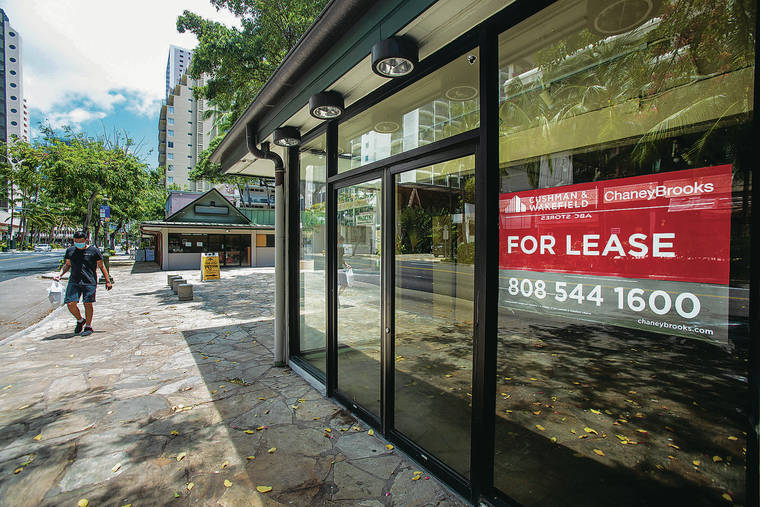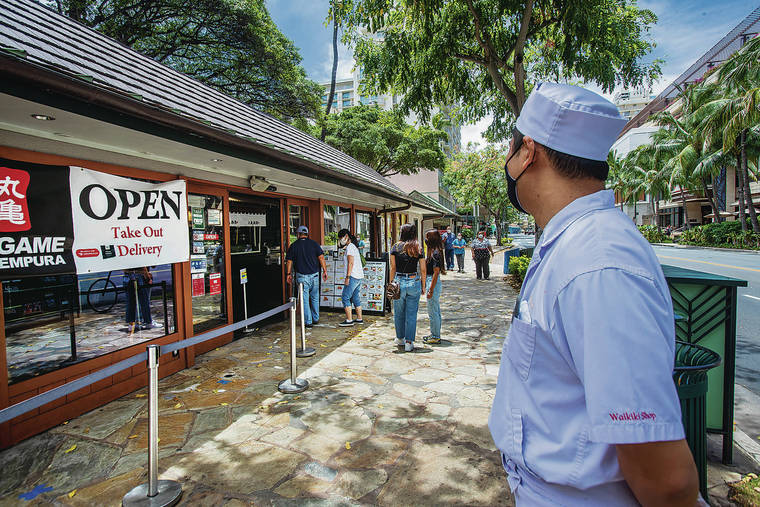COVID-19 downturn puts Hawaii businesses on the brink

DENNIS ODA / DODA@STARADVERTISER.COM
The economic downturn sparked by the COVID-19 pandemic has caused some businesses to permanently close. Stores on Kuhio Avenue between Nahua and Nohonani streets in Waikiki are now closed and vacant.

DENNIS ODA / DODA@STARADVERTISER.COM
Tetsuya Ishihara, general manager of the Waikiki Marukame Udon, stood in front of the noodle shop on Tuesday. Ishihara said the restaurant’s business has fallen to one quarter of what it was before the COVID-19 pandemic. “Local customers are helping us survive the downturn, but I’m sad that other businesses around us have closed,” Ishihara said.


Diners used to snake across the sidewalk waiting to get into Marukame Udon during peak meal times.
The Waikiki noodle shop and other smaller businesses around it once benefited from the visitor traffic along Kuhio Avenue, a main artery in the tourist district that once contributed 6% to the state’s gross domestic product. But that was before COVID-19 fears Opens in a new tab and government containment policies shut down tourism and caused businesses across the state to close, some permanently.
The recent lifting of some government regulations has allowed Marukame Udon to reopen. But it’s a sign of the times that it’s now surrounded by empty storefronts with leasing signs instead of customers seeking their udon fix.
Tetsuya Ishihara, general manager of the Waikiki Marukame Udon location, said local residents have kept the business afloat. But without tourists there’s only been enough demand to bring back about half of the shop’s employees.
“Local customers are helping us survive the downturn, but I’m sad that other businesses around us have closed,” Ishihara said. “If there’s less business, we’ll get less foot traffic. We want it to pick up so we can bring all of our employees back. We don’t want them to have to worry.”
Most businesses across the state also depend on tourism. Many say their survival depends on the reopening of out-of-state tourism, which collapsed with the March 26 implementation of a mandatory 14-day self-quarantine for trans-Pacific passengers. On Friday, only 375 visitors came to Hawaii. Daily passengers to Hawaii averaged 35,000 in June 2019.
Don't miss out on what's happening!
Stay in touch with breaking news, as it happens, conveniently in your email inbox. It's FREE!
Rick Egged, Waikiki Improvement Association president, said he’s getting indications that “a number of businesses aren’t going to reopen — ever.”
“Businesses that were only doing marginally during the best of times don’t want to go through the costly and lengthy process of trying to rebuild their business,” Egged said. “If your business was not flourishing in February, it’s hard to justify putting more money into it.”
Post COVID-19 business changes that reduce customer capacity and require investments in new safety protocol and equipment are squeezing already narrow margins, he said.
TROUBLE IN CHINATOWN
Chu Lan Shubert-Kwock, who is president of the Chinatown Business and Community Association and a member of the Downtown-Chinatown Neighborhood Board, said businesses there are reeling too.
Only about 70 of 300 or so Chinatown businesses have reopened, and most of those are still operating on limited hours, Shubert-Kwock said.
“Many businesses are hurting and deciding if they should reopen. Those that have reopened still aren’t getting the business that they need to make a profit,” she said. “Some businesses have closed permanently and more are on the brink. We haven’t even seen the peak yet. July and August will be really bad unless we have a way to assure people that COVID-19 won’t spread.”
Shubert-Kwock said she expects up to half of Chinatown’s businesses could close unless the city and state make more CARES Act funds available to them.
VACANCY RATES
Mark Bratton, senior vice president for Colliers International, said commercial properties throughout Hawaii are feeling the burn, with 41 of them already on a commercial mortgage-backed securities watch list with a servicer appointed to monitor their loans.
“It’s a relatively small percentage of the total commercial properties, but I’d say half of the properties on the watch list went on it because of COVID-19,” Bratton said. “There are some big hotels, large retailers and some very well capitalized owners on the list.”
Bratton said so far the only foreclosures on the watch list were already there before COVID-19. However, the timing of tourism’s reopening is crucial as many commercial properties and their lenders have kicked the can down the road.
“I don’t think we’ll see that many foreclosures or sales for a year or two, but eventually bond holders may say enough is enough,” he said.
Mike Hamasu, Colliers International director of consulting and research, said the firm is anticipating Oahu vacancy rates at office spaces will rise from about 10% in the first quarter to 12% by year’s end. Hamasu said the firm expects a steeper rise in vacancy rates for Oahu retail space, which could rise from about 6% during the first quarter to somewhere between 8% and 10% by year’s end.
Stephany Sofos, a Hawaii-based real estate analyst, said most Hawaii businesses that were impacted by COVID-19 will need concessions and support.
“You can’t expect a tenant that has been mandated by the government to only use 30% of their space to pay 100% of their rent,” Sofos said. “Places like Waikiki had high rents, which were based on high traffic — that’s all gone now.”
REOPENING TOURISM
State economist Eugene Tian has estimated Hawaii’s local economy will take at least two years to come back and tourism could take up to six years. Tian has forecast Hawaii will get only about 3.4 million visitors this year, that’s a 68% drop from last year’s 10.4 million visitor arrivals.
Bratton and others say that if Hawaii finds a way to safely reopen trans-Pacific tourism that the state’s recovery still might follow a V-shaped recovery path instead of a longer U-shaped curve.
“A lot of us believe that there is a lot of pent-up demand for travel to Hawaii,” Bratton said. “I was talking to hoteliers on Friday who think Hawaii could still salvage summer if tourism gets opened by August. Some properties in Southern California already are getting their price points back.”
Preliminary licensing and vocational numbers from the state Department of Commerce and Consumer Affairs could be an early indicator that despite the hardships, some businesses are betting that they will pull through. As of Tuesday, 57% of businesses already had completed their June professional and vocational licensing requirements.
But in order for these businesses and others to succeed, Hawaii likely will need to reopen tourism, which before COVID-19 declines supported roughly 216,000 jobs statewide.
The Chamber of Commerce Hawaii is calling for Gov. David Ige to allow for the safe reopening of trans-Pacific travel before July 31, which currently marks the end of the out-of-state passenger quarantine. The chamber also is soliciting signatures on a petition to reopen travel safely and expedite other measures that will save businesses.
“Every day we inch closer to an economic cliff that will close businesses permanently and destroy our local business community beyond repair if tourism does not reopen,” Sherry Menor-McNamara, Chamber of Commerce Hawaii president & CEO said. “Local businesses and workers will pay the price if safe, decisive and swift action isn’t taken.”
Moreover, Menor-McNamara said desperation is mounting for businesses that staved off some of the COVID-19 decline with Paycheck Protection Program loans that are now coming to an end.
“Many businesses are on their last life line,” Menor-McNamara said.
Ige announced earlier this month that the interisland passenger quarantine would end on June 16. He’s also talked about the state pursuing “travel bubbles” that would lift restrictions for other destinations that have low COVID-19 counts like Japan, Korea, Australia and New Zealand.
Bratton said “travel bubbles” are a good start, but would disproportionately benefit Oahu and Waikiki, which get most of the state’s international arrivals.
A hui led by Lt. Gov. Josh Green is trying to organize a plan to reopen Hawaii tourism this summer with a test-based travel policy that gives incoming passengers an alternative to quarantine.
“I think Gov. Ige is trying to make us the safest place on earth, which is good, but we can’t have our borders shut forever. We’ve got to take some risk and manage it,” Bratton said. “The impacts of not reopening tourism soon are just unimaginable.”
Is the glass half full? by Honolulu Star-Advertiser on Scribd



